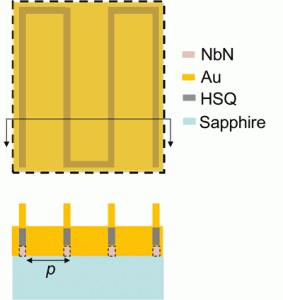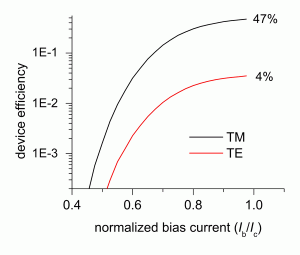Optical-antenna-integrated Superconducting Nanowire Single-photon Detectors
We designed and fabricated superconducting nanowire single-photon detectors (SNSPDs) with nano-optical antennae to reduce the length of the nanowire needed for efficient optical coupling. In our design, we increased the pitch of the meander and added a gold nano-optical antenna structure together with a top reflector to enhance the absorptance of the niobium nitride (NbN) nanowire for transverse-magnetically (TM) polarized incident light. This structure simultaneously suppressed the absorptance of transverse-electrically (TE) polarized light. The mechanism by which the antennae increase the absorption of TM-polarized light can be understood by modeling the structure as an array of slot waveguides. We experimentally demonstrated 47% device efficiency for a 9 mm × 9 mm, 600-nm pitch SNSPD for the TM-polarization and 4% for the TE-polarization, consistent with theoretical predictions. The reduction of the length of the nanowire shortened the detection efficiency recovery time for the detector after pulsing. The total length of the antenna-coupled nanowire was 145 mm. Compared with a typical (non-antenna coupled), 200-nm pitch SNSPD with the same area, the length of the nanowire was reduced by 2/3, and therefore the speed is expected to have been increased by a factor of 3.
At MIT Lincoln Laboratory, this work was sponsored by the United States Air Force under Air Force Contract #FA8721-05-C-0002. Opinions, interpretations, recommendations and conclusions are those of the authors and are not necessarily endorsed by the United States Government.
-
Figure 1: A schematic of optical-antenna-integrated superconducting nanowire single-photon detector. Compared with the past design [1], this design has gold structures between HSQ pillars to collect and focus light into NbN nanowire. The sparser meander with a pitch, p, makes the overall length of the nanowire shorter, yielding a faster detector.
- Figure 2: Measured device efficiency of the antenna-integrated superconducting nanowire single-photon detector for two polarizations.
References
- K.M. Rosfjord, J.K.W. Yang, E.A. Dauler, A.J. Kerman, V. Anant, B.M. Voronov, G.N. Gol’tsman, and K.K. Berggren, “Nanowire single-photon detector with an integrated optical cavity and anti-reflection coating,” Optics Express, vol. 14, issue 2, pp. 527-534, Jan. 2006. [↩]

